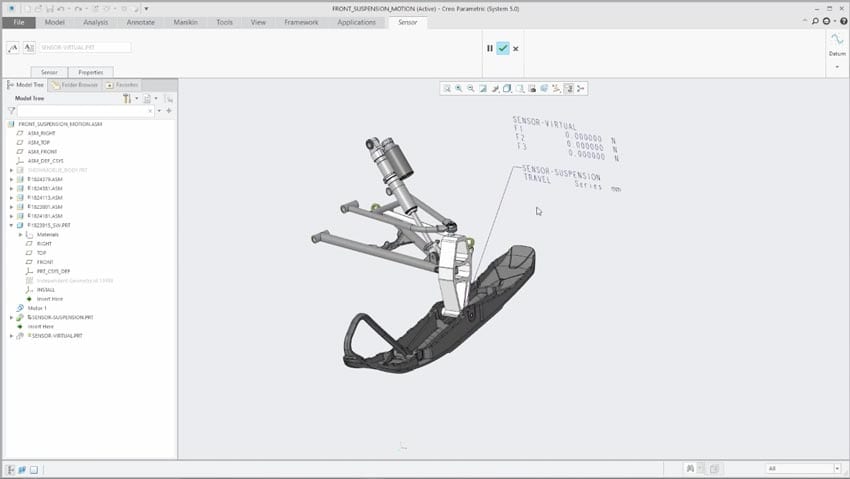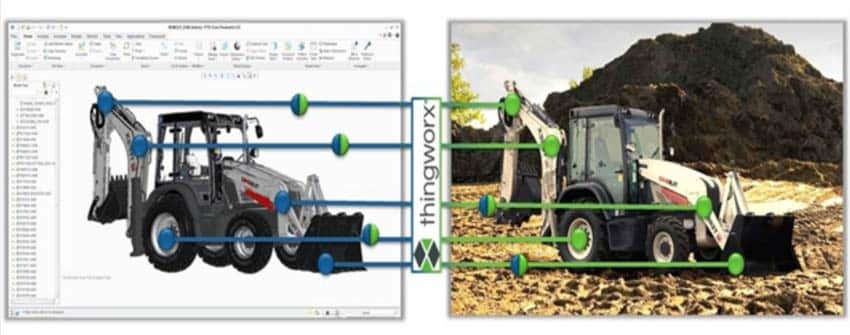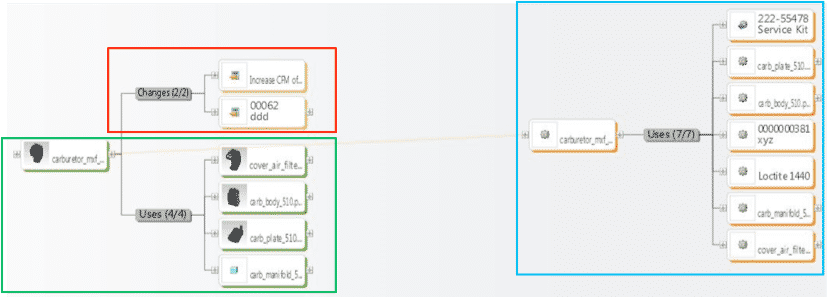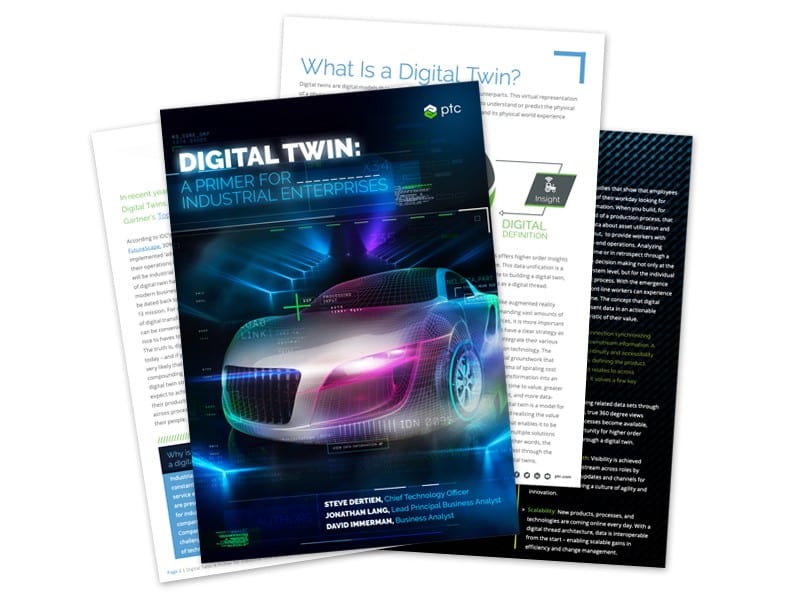- Reuse and instrument released designs
- Embed sensors into new designs
- Connect CAD models via digital twins to real-world data
- Use real-world sensor data in CAD design
- Integration with ThingWorx, the world’s leading industrial IoT platform
- Prepare for Product as a Service
Remember in 1977 when Ken Olson, the founder of Digital Equipment Corporation said, “there is no reason anyone would want a computer in their home”? Boy was he wrong. Not even a leader in the technology industry could predict how quickly our usage of technology would change.
If you don’t make an effort to keep up with the fast pace of technology; you will fall behind. It’s critical that you proactively embrace and move towards digital processes to ensure that future products better meet the needs of customers.
What better way to keep up with the future than making highly accurate product performance and behavior predictions with the right design tools?
PTC developed a Creo extension called Creo Product Insight. It lets designers and engineers incorporate the latest sensor technology into their designs.
What is Creo Product Insight?
Creo Product Insight captures and analyzes product data from live sensors on prototypes and products directly within your CAD model. This tool produces a digital twin, an exact replica of a physical prototype in a virtual CAD model, to mirror the performance of a product under real-world conditions.
How does it work? You add digital sensors from a library directly into your CAD models in Creo. Then you connect them to the data streams from physical products. Whether you’re looking to get more value out of your prototypes, design smart connected products, or use data to improve the quality of existing products, the Creo Product Insight Extension allows you to design smarter.
So how are organizations keeping up with the digital transformation with the Creo Product Insight Extension?
Improving New Product Design
When you’re improving new product design you’re most likely basing your design decision on assumptions and historical data. This puts you in a difficult spot because you may not have up-to-date-information which may cause inaccurate solutions and error-prone results.

Creo Product Insight allows you to validate design assumptions using real-world data from the field directly in Creo’s simulation and analysis tools. Using this extension also decreases your reliance on building prototypes because it gives you live product performance and behavior.
Improving Existing and Next-Generation Product Designs
The absence of real-world product data stunts the optimization of current and future products. If you had access to real-world data, you would be able to validate design criteria against customer usage data and mitigate risk of product failure, warranty, repair, and liability.
With Creo Product Insight and ThingWorx you can analyze field data and provide meaningful information back to engineering. Using real-world data allows you to identify opportunities for new products in the market and understand over and under engineered designs to reduce product life cycle costs.
Improving Smart Connected Product Design
The lack of specialized tools that support smart connected products puts you at risk of falling behind the digital transformation process. When sensors and a strategy to capture real-live data are disconnected from your design process there is no way to deliver the value that your customers deserve out of their products.
Creo Product Insight gives you the ability to optimize sensor replacements, choose a sensor type, and validate data capture requirement during the design process. The extension creates an integrated design process that delivers optimal value from smart connected products.

Creo Product Insight Capabilities and Benefits
Capabilities:
Benefits
- Eliminate manual workflows to use real-world sensor data in design
- Optimize products to real-world conditions
- Ensure that future products better meet the needs of customers
- Creo analyses outside of the design office
- Decrease reliance on physical prototyping
Creo Product Insight Licensing and Creo Version Capabilities
The Creo Product Insight is an add-on extension that is available for subscription licensing only. You do not need ThingWorx to use this extension – although using ThingWorx with it will fully optimize your results.
“Physical” Sensors – Creo 4 (M020):
- Easily define and place ‘measure’ sensors by adding physical sensors to Creo Assemblies
- New Instrumented sub-type to protect reused/released design data
- Associated parameter and input definitions and associated calculations
- Define (physical) calculating sensors (M020) to report analysis results (center of gravity, mass, area, etc.)
UX Sensors – Creo 4 (M030 & M040):
- Connection to ThingWorx to support reporting analyses results (M040)
- Run Creo analysis using Behavioral Modeling, Simulation, and Mechanism Dynamics (M040)
- Read real-world data from ThingWorx (or CSV data file) and use input variables to run analyses and report results back to data tables
“Virtual” Sensors – Creo 4 (M050):
- Specialized Virtual sensor handling – (excluded from BOM, meshing, and graphics)
- Directly connect and read sensor data from file or ThingWorx
- Use real-world sensor data to drive simulations
- Creo as a Service from ThingWorx (M050)
- Save/Export analysis results together with input values back to data file
Get live data from CAD models
Download the Creo Product Insight datasheet or watch this webinar replay to learn more and see if your organization could benefit from collecting live data directly within your CAD models. I’m willing to bet it can.
In a recent Tip of the Week video over on our YouTube channel (https://youtube.com/eacpds) I talked about a new feature in PTC Creo 5.0 – Topology Optimization. Topology optimization has been around for about 20 years, but primarily as stand alone solutions. In spring 2018 PTC announced they had fully embedded a solution from the folks over VR&D into their flagship CAD tool.
This is big news because it allows every user to easily optimize designs in new ways; whether designing for traditional manufacturing or additive manufacturing / 3D printing. Light weighting a part or assembly while maintaining structural integrity is an important part of modern product development. Optimizing topology reduces shipping weight and costs, may improve user experience, and lowers material costs. I’m sure there are other benefits, but those alone can help companies compete in today’s global economy.
After talking with some of our technical resources and engineers, it sounds like the built in Creo 5.0 tool does a fantastic job shrink wrapping/finalizing the optimized geometry to ensure the surfaces can be solidified and don’t have any weird overlapping surfaces or gaps. Most topology optimization tools kick out facetted surfaces that still need to be smoothed out in another tool. Creo turns the optimized geometry into a Creo Freestyle surface that can be easily solidified. This is especially important when optimizing parts for 3D printing.
We’d love to show you this Creo functionality live. So, after you watch the tip of the week video, head over to our contact page to request a demonstration.
Part II – (You can read part 1 here) Evolving your BoM strategy, tools, and abilities. “EBoM vs. MBoM” transforms into “EBoM integrates with MBoM.” This integration includes associativity to one another, time saving tools, elimination of error prone manual steps & more.
Imagine eliminating the common disjointed processes, additional time, and error prone manual steps involved in the creation of downstream BoMs from Engineering into Manufacturing, Production and Service management.
Concepts & examples such as Manufacturing Bill of Materials (MBoM) are shown below, all under one system, integrated & associated, and created with a single click. Then they’re easily edited to meet downstream BoM needs.
BoM creation can be streamlined & improved by associatively creating downstream BoMs (S or M or other) and eventually, connecting them to your ERP system. For now, we’ll focus on the first step of this business transformation concept; the creation of the second, or downstream M or SBoM, starting with a simple EBoM example, created in minutes, and easily viewed & tracked.
Who should be involved in this topic at your company? Ideally, your Configuration Manager role should be leading or heavily involved in this process.
The starting point & tool is PTCs Windchill and your willingness to change & improve.
Once your CAD data is ready to check into Windchill, there is an option (check box) to auto-associate the EBoM to a downstream BoM such as an MBoM. It is a 1:1 relationship for starters. Options can branch out from here into many CM (Configuration Management) directions. Such as multi-level BoM management, uses, visualization and more.
Once created, you can manipulate & edit the default 1:1 downstream BoM to your needs; adding bulk items, manufacturing specific sub assemblies, (build throughs) even new service end items. You can also flatten out an EBoM to meet assembly or production needs. BoM items such as adhesive, lubricant, paint or coatings, packaging items, all things that typically are not on an EBoM, can and do belong on the M or SBoM.
If this fits your company’s needs? consider using Windchill’s auto-associate feature.
This article covers a couple examples. If this is not deep enough…here are even more tools to consider. Topics such as creating associated manufacturing instructions, work instructions, work plans and more. Change Management is shown as reference only, it is an optional element of Windchill for another blog.
There are many options to this topic, these are common examples that fit a lot of needs and is considered a starting point.
1stexample shows all BoM & change components all connected in one system vs. manually done in silo fashion, which is industry’s most common method today. These examples are shown in PTCs Windchill reference viewer tool, which ties all related objects into view for easy visibility with just a few clicks.
- 1. EBoM structure (highlighted in green)
- 2. Change requests, notices and tasks (highlighted in red)
- 3. MBoM structure (highlighted in blue) with their own, or connected Change Management Requests, Notices & Tasks

2ndexample shows an EBoM, SBoM (Service Kit in this example), with a saleable end item service kit, as well as components for service or manufacturing BoMs. It also shows Changes, these can also be created, edited, routed, approved or rejected, and even include the SBoM if need be.

Please connect with EAC to learn more, to discover your company’s transformation opportunities with an assessment, maybe see a demo, or attend a webinar. The goal is to help your company transform how you design, manufacture, connect to and service your products.
Designing a product without integrating simulation into your workflow is like giving a concert but never rehearsing. Why would you do that?
Top Performing organizations meet cost targets, remain on spending plans, and beat their due dates. One way they accomplish these objectives is by utilizing simulation tools to empower their organizations. Here’s 10 ways simulation will put you ahead.
1. Simulation software = better design decisions
Simulation tools enable engineers to have better insights throughout the design process.
For example, with the use of simulation engineers can conduct sensitivity studies, analyze trade-offs, remove excess materials and even evaluate motion envelopes.
By using simulation during concept design, engineers are able to explore and consider more options.
These options permit engineers to see the influences and effects of different design guidelines and limitations.
Testing many conditions, simulation software allows engineers to narrow down choices for the best concept.
This is how engineers are able to make better, highly informed design decisions.
2. Simulation helps avoid over engineering
By simulating your designs in a variety of environments, you can easily determine what is necessary within your design and what is not.
This helps engineers eliminate excess materials, and ultimately create better products.
3. With Simulation software, you find problems earlier (while they’re still cheap to fix)
Engineering simulation software helps organizations discover hidden interactions that can cause big problems.
How? It’s simple.
If the materials you’re using to build and design a product can’t perform under stress, you can find out early in the design process.
This helps your design team get it right the first time.
4. Simulation tools improve product quality
Simulation tools enable engineers to analyze and validate the performance of 3D virtual prototypes before the part itself is created.
With the ability to validate and test designs early in the design process, engineers are able to create and evaluate more concepts and ideas within allotted time frames.
This means more ideas, more designs, better quality and ultimately a better product.
5. Simulation software improves product reliability
With simulation software, results are accurate and reliable and can be easily calculated with very little input from engineers.
By using simulation-driven design to optimize product performance, quality and durability- you can be sure that your is more than reliable.
6. Simulation tools cut product development time
Organizations are able to reduce product development time with simulation tools because less time is needed for physical testing, fixing late problems, and rework.
When design engineers know how to run simulations, they understand the requirements for the analysis model. By taking these requirements into consideration as they design, model, and build products, the analysis becomes easier and takes less time to prepare.
7. Innovation is increased with simulation
With the help of simulation tools, engineers can also be more innovative.
Time-savings allotted from simulation and virtual prototypes enable design engineers to evaluate more design iterations.
8. Simulation helps you get to market faster
Simulation tools help streamline product development activities by enabling concurrent design and analysis.
How? It’s simple.
With simulation, the analysis process is faster. For instance, you can forget any reliance on 3rd parties for analysis because you are able to now do it in-house.
By identifying and eliminating errors early in the design process you will resolve errors early, eliminating late-stage changes and tedious rework. This will also greatly speed up your processes.
Simulation tools empower design engineers to make better design decisions.
Better design decisions ultimately produce more competitive products that cost less and get to market faster.
9. In the long run, simulation tools save costs
Simulation helps engineers make better design decisions at much less cost because they can subject virtual models to real-world forces.
By using fewer prototypes and focusing simulation on areas of high sensitivity and fatigue, an organization can save time and money.
For example, engineers can reduce product costs by optimizing designs to meet multiple objectives, such as maintaining a product’s strength while reducing its weight.
This is exactly how the use of analysis and early optimization to properly size geometry can reduce material costs.
Aside from material costs, how do product failures, warranty, and repair cost impact company profits? Tremendously.
Using simulation tools organizations can avoid costly recalls and reduce after-market service, warranty, and repair costs.
It’s easy to see how simulation tools will save you money simply by eliminating the need for project re-work, prototyping, and over-engineering
10. More competitive products
Simulation software provides engineers with additional insight, which leads to better design decisions and product optimization.
By using simulation, design engineers are able to develop higher quality products that are easily differentiated in the market.
The rapid development of technology has transformed traditional modeling methodologies and provided new ways to deliver digital 3D models and product data. Computer-aided design (CAD) now gives users the tools used in all stages of product development from concept development to final presentation. Not only are the products changing with technology advances, the tools we use to design the products are changing too.
So how exactly is augmented reality changing the way you do your work? Here are 3 ways Augmented Reality is reinventing your design process.
AR makes your workspace way more flexible
You won’t have to be constrained to your desk to design products anymore. AR allows you to take your design beyond where you traditionally have done the bulk of your work. With the help of smart glasses, tablets, and mobile phones, you can design, and experience your designs anywhere you want whether it’s at your desk, in a conference room, or on a shop floor.
AR allows you to fully conceptualize designs
Digitally generated 3D models created within CAD software have a limitation – the rendering of the design is still stuck inside of a flat screen. Augmented reality allows you to fully conceptualize designs when they’re superimposed on the physical world. Augmented reality allows you to sit inside your design as you’re creating it – enhancing engineers’ ability to evaluate and improve designs. This lets you fully appreciate characteristics of a design at full, partial, or expanded scale in its intended setting.
AR reduces time and money spent on prototyping
Augmented reality gives designers and engineers the ability to view accurate representations of finished products in real-world scenarios without expensive prototypes. It eliminates the constant need to build multiple and costly prototypes because you’re able to see any design flaws in a half virtual, half physical world. By the time you’re ready to send your draft to a 3D printer or manufacturer, you’re already very confident in your design.
If you’re not already using AR in your design process, it probably won’t be long before you are. Companies like PTC are leading the way to innovation and new design processes by integrating Augmented Reality (AR) capabilities into their CAD software, Creo Parametric. Creo AR allows you to rapidly create AR experiences directly from Creo, easily manage and control viewer access, rapidly distribute and share AR experiences, and effectively communicate and collaborate design information.
Start creating, publishing, and sharing augmented reality experiences with Creo AR – download the datasheet to learn more.
There are a lot of things in life we as humans seem to put on autopilot. We seem to do things the same way, around the same time, even sometimes in the same place. Despite our best efforts to be different, we find ourselves thinking, behaving, and feeling the same way we did yesterday and the even days, months, and years before that. It’s time to challenge your ways.
Look at the way you do things for instance.
If you’re anything like me, you have routines for almost everything you do, from the time you wake up to the time you go to work. We often get so accustomed to how we do things, finding the reasons why we do them becomes a challenge. It is easy to overlook our other options if we fail to recognize the benefits of change. It is this very mindset that holds us, and the rest of the world from reaching our full potential.
Aside from personally challenging our ways, we should also be challenging our business processes.
It is my belief that companies, more than individuals, tend to do what they’ve always done. We become comfortable in the systems we know, the methods we have created, and the processes we have established. This is when we fail to recognize opportunity in organizational change.
Although the concept of change can be frightening for some the reality is, success doesn’t originate within our comfort zones.
If we never reevaluate or challenge the way we do things, how would we ever get better? I believe the answer is, we wouldn’t. As the quote often attributed to Albert Einstein states, “insanity is doing the same thing over and over again and expecting different results.”
We must acknowledge our propensity to build repetitive cycles in order to successfully grow our businesses, change and be different. After all, change is the vital element for both success and survival.
With the rapid advancement of technology our world is changing more than ever.
This means our organizations must quickly change, too. It is crucial that we optimize our business practices by looking at our operations and leveraging the resources we use to get things done. In order to grow and prosper, we must recognize our patterns and learn how to change them.
Taking an engineering department for example, your in-house staff may know your business or a particular CAD (Computer Aided Design) package, but are they experts at prototyping, simulation, electronics, and new materials? This is example is where utilizing a fresh perspective could more than benefit your company.
Now look at the systems your company currently depends on.
The methods by which you currently transfer documents, communicate through departments, and transmit information. These are the systems we ultimately forget to challenge. As we become comfortable in our ways, we forget our competitors might be challenging theirs. You might think to yourself.., ‘So what if our department communication may not be the most efficient process’ , but what if speeding up communication would bring your cost down by up to 10 percent! What if your communication systems boosted your competitive advantage, and ultimately accelerated your time to market? These everyday, repetitive processes are what I am challenging you to re-think.
Organizations benefit from change.
A change within an organization results in new ways of looking at customer needs, new ways of delivering customer service, new ways of strengthening customer interactions and new products that might attract new markets. But what many fail to realize is that many of these are driven from internal practices.
If you can imagine the kind of businesses that will all be able to help you improve the products you’re making, then you can see a world where people are able to find a lot more success.
![]()
Change is what allows us to explore new opportunities, learn new skills and exercise our creativity.
If nothing else, I challenge you to be fearless in the pursuit of what sets you and your solutions apart. I challenge you to re-think your ways and become the best you can be.
